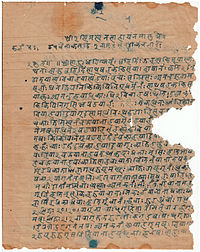| Newari scripts | |
|---|---|
 | |
| Script type | Abugida |
| Direction | Left-to-right |
| Region | Nepal and India |
| Languages | Nepal Bhasa |
| Related scripts | |
| Parent systems | Proto-Sinaitic script |
| Child systems | Ranjana, Bhujimol, Pracalit |
| This article contains phonetic transcriptions in the International Phonetic Alphabet (IPA). For an introductory guide on IPA symbols, see Help:IPA. For the distinction between , / / and ⟨ ⟩, see IPA § Brackets and transcription delimiters. | |
| Brahmic scripts |
|---|
| The Brahmi script and its descendants |
| Northern Brahmic |
| Southern Brahmic |
Newari scripts (Nepal Lipi: 𑐣𑐾𑐥𑐵𑐮 𑐁𑐏𑐮, Devanagari: नेपाल आखल) are a family of alphabetic writing systems employed historically in Nepal Mandala by the indigenous Newar people for primarily writing Nepal Bhasa. It is also used for transcribing Sanskrit and Pali. There are also some claims they have also been used to write the Parbatiya (Khas) language.
These scripts were in widespread use from the 10th to the early 20th-century, but have since been largely supplanted by the modern script known as Devanagari. Of the older scripts, about 50,000 manuscripts written in Nepal Lipi have been archived.
History





Pre development
Prior to development of Nepal Scripts, people in the Nepal Mandala used the following scripts which are shared within the South Asian region.
- Brāhmī script – Ashoka period
- Purva Licchavi Script – prior Licchavi period
- Uttara Licchavi Script – later Licchavi period (6th–11th or 12th century)
Early usage and development
The 'Nepal Script' or 'Nepalese script' appeared in the 10th century. The earliest instance is a manuscript entitled Lankavatara Sutra dated Nepal Era 28 (908 AD). Another early specimen is a palm-leaf manuscript of a Buddhist text the Prajnaparamita, dated Nepal Era 40 (920 AD). One of the oldest manuscript of Ramayana, preserved till date, was written in Nepal Script in 1041.
The script has been used on stone and copper plate inscriptions, coins (Nepalese mohar), palm-leaf documents and Hindu and Buddhist manuscripts.
Among the famed historical texts written in Nepal Lipi are Gopalarajavamsavali, a history of Nepal, which appeared in 1389 AD, the Nepal-Tibet treaty of Nepal Era 895 (1775 AD) and a letter dated Nepal Era 535 (1415 AD) sent by Chinese Emperor Tai Ming to Shakti-simha-rama, a feudatory of Banepa.
Besides the Kathmandu Valley and the Himalayan region in Nepal, the Ranjana script is used for sacred purposes in Tibet, China, Japan, Korea, Mongolia, Bhutan, Sikkim and Ladakh.
The Jokhang Temple in Lhasa, Tibet is ornamented with mantras embossed in Ranjana script, and the panels under the eaves are numbered using Nepal Lipi.
Decline
In 1906, the Rana regime banned Nepal Bhasa, Nepal Era and Nepal Lipi from official use as part of its policy to subdue them, and the script fell into decline. Authors were also encouraged to switch to Devanagari to write Nepal Bhasa because of the availability of moveable type for printing, and Nepal Lipi was pushed further into the background. However, the script continued to be used for religious and ceremonial purposes till the 1950s.
Revival
After the Rana dynasty was overthrown and democracy established in 1951, restrictions on Nepal Bhasa were lifted. Attempts were made to study and revive the old scripts, and alphabet books were published. Hemraj Shakyavamsha published an alphabet book of 15 types of Nepalese alphabets including Ranjana, Bhujimol and Pachumol.
In 1952, a pressman Pushpa Ratna Sagar of Kathmandu had moveable type of Nepal script made in India. The metal type was used to print the dateline and the titles of the articles in Thaunkanhe monthly.
In 1989, the first book to be printed using a computer typeface of Nepal script, Prasiddha Bajracharyapinigu Sanchhipta Bibaran ("Profiles of Renowned Bajracharyas") by Badri Ratna Bajracharya, was published.
Types
The scripts known to have been used by the Newar people of pre-Gorkha Nepal (i.e., Nepala Mandala) or dynasties that ruled over them in history are as follows:
- Rañjana style
- Flat-headed style
- Prachalit script
- Pāchūmol script
- Hiṁmol script
- Kuṁmol script
- Curve-headed style
- Bhujiṁmol script
- Golmol script
- Kveṁmol script
- Litumol script
Among the different scripts based on Nepal script, Ranjana (meaning "delightful"), Bhujinmol ("fly-headed") and Prachalit ("ordinary") are the most common. Ranjana is the most ornate among the scripts. It is most commonly used to write Buddhist texts and inscribe mantras on prayer wheels, shrines, temples, and monasteries. The popular Buddhist mantra Om mani padme hum (meaning ("Hail to the jewel in the lotus" in Sanskrit) is often written in Ranjana.
Description
Consonants
| Pracalit | Rañjanā | Dev. | Rom. |
|---|---|---|---|
| क | ka | ||
| ख | kha | ||
| ग | ga | ||
| घ | gha | ||
| ङ | ṅa | ||
| ह्ङ | ṅha | ||
| च | ca | ||
| छ | cha | ||
| ज | ja | ||
| झ | jha | ||
| ञ | ña | ||
| ह्ञ् | ñha |
| Pracalit | Rañjanā | Dev. | Rom. |
|---|---|---|---|
| ट | ṭa | ||
| ठ | ṭha | ||
| ड | ḍa | ||
| ढ | ḍha | ||
| ण | ṇa | ||
| ह्ण | ṇha | ||
| त | ta | ||
| थ | tha | ||
| द | da | ||
| ध | dha | ||
| न | na | ||
| ह्न | nha |
| Pracalit | Rañjanā | Dev. | Rom. |
|---|---|---|---|
| प | pa | ||
| फ | pha | ||
| ब | ba | ||
| भ | bha | ||
| म | ma | ||
| ह्म | mha | ||
| य | ya | ||
| र | ra | ||
| ह्र | rha | ||
| ल | la | ||
| ह्ल | lha | ||
| व | va |
| Pracalit | Rañjanā | Dev. | Rom. |
|---|---|---|---|
| श | śa | ||
| ष | ṣa | ||
| स | sa | ||
| ह | ha | ||
| क्ष | kṣa | ||
| त्र | tra | ||
| ज्ञ | jña |
The compound letters kṣa, tra and jña are often regarded as separate letters that are taught together with the other letters. Since the Newari language lacks retroflex consonants, the letters ṭa, ṭha, ḍa, ḍha, ṇa and ṣa are used only in loanwords. The same applies to the letter śa. Newari, on the other hand, has a number of sonorant consonants that are pronounced with creaky voice (ṅha, ñha, ṇha, nha, mha, rha and lha). They are written in compound letters consisting of "ha" combined with the letter for the corresponding modal sonorant.
Contextual forms

Some letters have alternative forms that are used when combined with certain vowel diacritics or included in a consonant cluster.
- Letter bha and ha changes appearance when combined with any of the vowel diacritics u, ū, ṛ, ṝ, ḷ and ḹ.
- Letter ja and ra forms ligatures together with the vowels u and ū.
- Vowels u changes appearance when combined with the letters ga, ta, bha and śa.
Compound letters
Consonant clusters are written by writing several consonant letters together in complex ligatures. How they are written depends on the shape of the letters and some letters have alternative shapes that are used depending on their position in the cluster.
Vowels
| Pracalit | Rañjanā | Dev. | Rom. |
|---|---|---|---|
| अ | a | ||
| आ | ā | ||
| इ | i | ||
| ई | ī | ||
| उ | u | ||
| ऊ | ū |
| Pracalit | Rañjanā | Dev. | Rom. |
|---|---|---|---|
| ऋ | ṛ | ||
| ॠ | ṝ | ||
| ए | e | ||
| ऐ | ai | ||
| ओ | o | ||
| औ | au |
| Pracalit | Rañjanā | Dev. | Rom. |
|---|---|---|---|
| अय् | ay | ||
| आय् | āy | ||
| एय् | ey |
The vowel ṛ which in Sanskrit stands for syllable forming is used in Newar script to write the syllable ri.
In Newari, the vowels a and ā are pronounced with different vowel qualities. In order to write their long equivalents, some diacritics have been given partially different properties than what is otherwise usual in Brahmic scripts.
| Letter | Name | Transcription | Description | |||
|---|---|---|---|---|---|---|
| Pracalit | Rañjanā | Sanskrit | Newari | Dev. | Rom. | |
| visarga | lyuphuti | अः | aḥ | Usually used to indicate that a vowel is followed by an h-sound. In Newari it is used instead of marking a long vowel. | ||
| candrabindu | milaphuti | अँ | am̐ | Marks a nasal vowel. | ||
| anusvāra | sinhaphuti | अं | aṃ | In other words, it can be seen as a combination of visarga and chandrabindu. | ||
Vowel diacritics
Pracalit
Some of the vowel diacritics have different appearances depending on whether the consonant has a top line or not. There are seven consonants without top lines: ga, ña, ṭha, ṇa, tha, dha and śa.
| a | aḥ | ā | āḥ | i | ī | u | ū | ṛ | ṝ | e | ai | o | au | am̐ | aṃ | |
|---|---|---|---|---|---|---|---|---|---|---|---|---|---|---|---|---|
| क ka |
||||||||||||||||
| ग ga |
Rañjanā
The vowel diacritics can have up to three different appearances depending on which consonant they are combined with. The rules for ka are also used for ja, kṣa and jña. The rules for ga also apply to kha, ña, ṭha, ṇa, tha, dha and sha. The rules for ba are used for other letters.
Current use
Nepal Lipi is available in Unicode as Newa script. It is the official script used to write Nepal Bhasa. Ranjana script has been proposed for encoding in Unicode.
The letter heads of Kathmandu Metropolitan City, Lalitpur Metropolitan City, Bhaktapur Municipality, Madhyapur Thimi Municipality ascribes its names in Ranjana Script.
In India, the official script for Newar language is Nepal Lipi.
Gallery
-
 Invitation card.
Invitation card.
-
 Thaunkanhe monthly.
Thaunkanhe monthly.
-
 Sandhya Times daily.
Sandhya Times daily.
-
 Copper inscription from 1952 AD.
Copper inscription from 1952 AD.
-
 Stone inscription from 1654 AD.
Stone inscription from 1654 AD.
-
 Embossed lettering from 1877 AD.
Embossed lettering from 1877 AD.
-
 Sanskrit Buddhist manuscript in Nepal script from 1869 AD.
Sanskrit Buddhist manuscript in Nepal script from 1869 AD.
-
 Table of Prachalit Nepal script.
Table of Prachalit Nepal script.
-
 An inscription from Bhaktapur in the Pracalit script dated February 1711 AD.
An inscription from Bhaktapur in the Pracalit script dated February 1711 AD.
See also
External links
- Nepal Lipi Prakash
- Nepalese Alphabets – Nepal Lipi Samgraha
- Nepal Lipi Varnamala
- Sankshipta Nepal Lipi Parichaya
- Table of Evolution of Nepali Scripts
- Nepal Lipi Vikas
- Nepal Lipi Vigyan Samanya Parichaya
- Nepalma Prachalit Lipiko Parichaya
Notes
- It is also named Pro-Licchavi or Pre-Licchavi. The Purva Licchavi script is closely related to the Gupta script. The Purva Licchavi Script – see Purva Licchavi.
- It is also named Uttar-Licchavi, Post-Licchavi or Kuṭila (the regional variants of the Siddham script). The Kuṭila script – see Category:Kutila script.
References
- Masica, Colin (1993). The Indo-Aryan languages. p. 143.
- Tuladhar, Prem Shanti (2000). Nepal Bhasa Sahityaya Itihas: The History of Nepalbhasa Literature. Kathmandu: Nepal Bhasa Academy. ISBN 99933-56-00-X. Page 306.
- Lienhard, Siegfried (1984). Songs of Nepal. Hawaii: Center for Asian and Pacific Studies, University of Hawaii, University of Hawaii Press. pp. 2, 14. ISBN 0-8248-0680-8. Retrieved 30 September 2013.
- Nepal-German Manuscript Cataloguing Project
- ^ Shakyavansha, Hemraj (1993, eighth edition). Nepalese Alphabet. Kathmandu: Mandas Lumanti Prakashan.
- ^ "Roadmapping the scripts of Nepal" (PDF). 2009-09-28. Retrieved 9 October 2020.
{{cite journal}}: Cite journal requires|journal=(help) - "Purva Licchavi – omniglot".
- Rajan, Vinodh. "Commentsonnamingthe"Siddham"encoding" (PDF).
- Pandey, Anshuman. "Proposal to Encode the Siddham Script in ISO/IEC 10646" (PDF).
The encoding for Siddham is to serve as a unifying block for all regional variants of the script, such as 'Siddhamātṛkā' and 'Kuṭila'. The representative glyphs are based upon Japanese forms of Siddham characters on account of active usage of the script by Japanese Buddhist communities
- Sakya, Hemaraj (2004) Svayambhū Mahācaitya: The self-arisen great Caitya of Nepal. Svayambhu Vikash Mandal. ISBN 99933-864-0-5, ISBN 978-99933-864-0-7. Page 607. Retrieved 29 March 2012.
- Shrestha, Rebati Ramanananda (2001). Newah. Lalitpur: Sahityaya Mulukha. Page 86.
- Institute of Scientific Research on Vedas
- Bendall, Cecil (1883). Catalogue of the Buddhist Sanskrit Manuscripts in the University Library, Cambridge. Cambridge: At the University Press. p. 301. Retrieved 21 August 2012.
- "Nepalese Inscriptions in the Rubin Collection". Retrieved 30 September 2013.
- Vajracarya, Dhanavajra and Malla, Kamal P. (1985). The Gopalarajavamsavali. Franz Steiner Verlag Wiesbaden GmbH.
- Tamot, Kashinath (2009). Sankhadharkrit Nepal Sambat. Nepal Mandala Research Guthi. ISBN 978-9937209441. Pages 68–69.
- Rolamba. April–June 1983.
{{cite news}}: Missing or empty|title=(help) - "Ranjana Alphabet". Lipi Thapu Guthi. 1995.
- Tuladhar, Kamal Ratna (second edition 2011). Caravan to Lhasa: A Merchant of Kathmandu in Traditional Tibet. Kathmandu: Lijala and Tisa. ISBN 99946-58-91-3. Page 115.
- Tuladhar, Prem Shanti (2000). Nepal Bhasa Sahityaya Itihas: The History of Nepalbhasa Literature. Kathmandu: Nepal Bhasa Academy. ISBN 99933-56-00-X. Page 14.
- Brown, T. Louise (1996). The Challenge to Democracy in Nepal: A Political History. Routledge. ISBN 0-415-08576-4, ISBN 978-0-415-08576-2. Page 21.
- Sada, Ivan (March 2006). "Interview: Hem Raj Shakya". ECS Nepal. Archived from the original on 26 January 2012. Retrieved 23 February 2012.
- "Nepal Lipi Sangraha" (PDF). Gorkhapatra. 20 April 1953. Retrieved 7 May 2012. Page 3.
- Tuladhar, Kamal Ratna (22 March 2009). "A man of letters". The Kathmandu Post. Archived from the original on 29 September 2011. Retrieved 23 February 2012.
- Lienhard, Siegfried (1984). Songs of Nepal. Hawaii: Center for Asian and Pacific Studies, University of Hawaii, University of Hawaii Press. p. 2. ISBN 0-8248-0680-8. Retrieved 30 September 2013.
- Shrestha, Bal Gopal (January 1999). "The Newars: The Indigenous Population of the Kathmandu Valley in the Modern State of Nepal)" (PDF). CNAS Journal. Retrieved 23 March 2012. Page 87.
- Manandhar, Dev Dass (5 February 2012). "Proposal for Nepālalipi Script in the Universal Character Set for inclusion in the Unicode Standard" (PDF). Retrieved 15 September 2015.
- ^ Pandey, Anshuman (29 February 2012). "Proposal to Encode the Newar Script in ISO/IEC 10646" (PDF). Retrieved 15 September 2015.
- Everson, Michael (4 May 2009). "Preliminary proposal for encoding the Rañjana script in the SMP of the UCS" (PDF). Retrieved 15 September 2015.
- Pandey, Anshuman (2023-01-05). "L2/23-028: Preliminary proposal to encode Ranjana in Unicode" (PDF).
- "कोभिड-१९ विरुद्धको Verocell दोश्रो मात्राको खोप लगाउन आउने बारे सूचना !". Kathmandu Metropolitan City. Retrieved 30 October 2021.An example of a letter head in Kathmandu Metropolitan City
- "प्रेस विज्ञप्ति". Lalitpur Metropolitan City. Retrieved 30 October 2021.An example of a letter head in Lalitpur Metropolitan City
- "आधारभूत तह (कक्षा ८) उत्तीर्ण परीक्षा २०७७ को नतिजा प्रकाशनसम्बन्धी सूचना !". Bhaktapur Municipality. Retrieved 30 October 2021.An example of a letter head in Bhaktapur Municipality
- "Notice for non-governmental social organizations". Madhyapur Thimi Municipality. Retrieved 30 October 2021.An example of a letter head in Madhyapur Thimi Municipality
- "𑐳𑐶𑐎𑑂𑐎𑐶𑐩 𑐴𑐾𑐬𑐮𑑂𑐜" (PDF). Government of Sikkim. Retrieved 1 November 2021.
| Topics of Newar people | |
|---|---|
| Music | |
| Cuisine | |
| Festival | |
| Rituals | |
| Architecture | |
| Language | |
| Deities | |
| Castes | |
| Misc | |
| Religion | |


